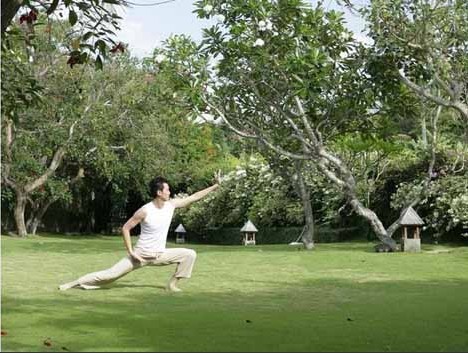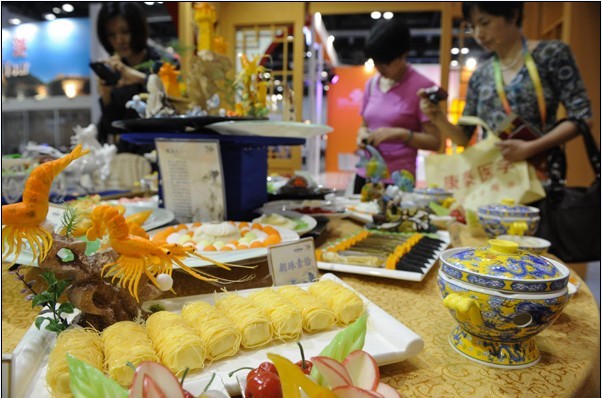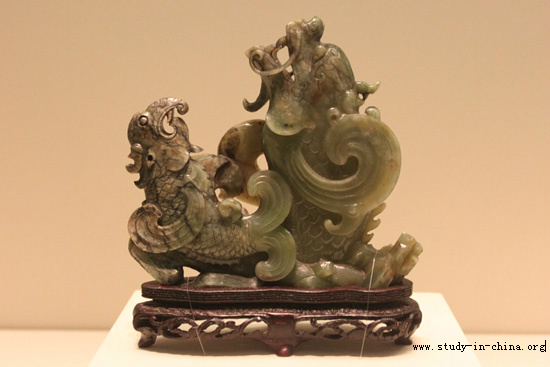| Home > China Feature |
History of Chinese martial arts

Descriptions of Chinese martial arts can be traced to the Xia Dynasty (夏朝) which existed more than 4000 years ago. Their origin is attributed to self-defense needs, hunting activities and military training in ancient China. Hand-to-hand combat and weapons practice were important components in the training of Chinese soldiers. From this beginning, Chinese martial arts proceeded to incorporate different philosophies and ideas into its practice—expanding its purpose from self-defense to health maintenance and finally as method of self-cultivation. Conversely, the influence of martial arts ideals in civilian society can be found in poetry, fiction, and eventually film. Chinese martial arts are now an integral element of Chinese culture.
According to tradition, the Yellow Emperor (Huangdi, traditional date of ascension to the throne 2698 BCE) introduced the earliest forms of martial arts to China.[8] The Yellow Emperor is described as a famous general who, before becoming China’s leader, wrote lengthy treatises on medicine, astrology and the martial arts. He allegedly developed the practice of jiao di or horn-butting and utilized it in war.
Shǒubó (手搏) kung fu, practiced during the Shang dynasty (1766–1066 BCE), and Xiang Bo (similar to Sanda) from the 600s BCE, are just two examples of ancient Chinese kung fu. In 509 BCE, Confucius suggested to Duke Ding of Lu that people practice the literary arts as well as the martial arts; thus, kung fu began to be practised by ordinary citizens external to the military and religious sects (pre-dating Shaolin by over 1,000 years). A combat wrestling system called juélì or jiǎolì (角力) is mentioned in the Classic of Rites (1st c. BCE). This combat system included techniques such as strikes, throws, joint manipulation, and pressure point attacks. Jiao Di became a sport during the Qin Dynasty (221–207 BCE). The Han History Bibliographies record that, by the Former Han (206 BCE – 8 CE), there was a distinction between no-holds-barred weaponless fighting, which it calls shǒubó (手搏), for which "how-to" manuals had already been written, and sportive wrestling, then known as juélì or jiǎolì (角力). Wrestling is also documented in the Shǐ Jì, Records of the Grand Historian, written by Sima Qian (ca. 100 BCE).
A hand to hand combat theory, including the integration of notions of "hard" and "soft" techniques, is expounded in the story of the Maiden of Yue in the Spring and Autumn Annals of Wu and Yue (5th c. BCE).
In the Tang Dynasty, descriptions of sword dances were immortalized in poems by Li Bai. In the Song and Yuan dynasties, xiangpu (the earliest form of sumo) contests were sponsored by the imperial courts. The modern concepts of wushu were fully developed by the Ming and Qing dynasties.
Martial arts are also mentioned in Chinese philosophy. Passages in the Zhuangzi (庄子), a Daoist text, pertain to the psychology and practice of martial arts. Zhuangzi, its eponymous author, is believed to have lived in the 4th century BCE. The Tao Te Ching, often credited to Lao Zi, is another Daoist text that contains principles applicable to martial arts. According to one of the classic texts of Confucianism, Zhou Li (周礼), Archery and charioteering were part of the "six arts" (六艺, including rites, music, calligraphy and mathematics) of the Zhou Dynasty (1122–256 BCE). The Art of War ( 孙子兵法), written during the 6th century BCE by Sun Tzu ( 孙子), deals directly with military warfare but contains ideas that are used in the Chinese martial arts. Those examples shows the ideas associated with Chinese martial arts changed with the evolving Chinese society and over time acquired a philosophical basis.
Daoist practitioners have been practicing Tao Yin, physical exercises similar to Qigong that was one of the progenitors to Tai Chi Chuan, at least since as early as 500 BCE. In 39–92 CE, "Six Chapters of Hand Fighting", were included in the Han Shu (history of the Former Han Dynasty) written by Pan Ku. Also, the noted physician, Hua Tuo, composed the "Five Animals Play"—tiger, deer, monkey, bear, and bird, around 220 BCE. Daoist philosophy and their approach to health and exercise might have influenced to certain extent the Chinese martial arts.
With regards to the Shaolin style of martial arts, the oldest evidence of Shaolin participation in combat is a stele from 728 CE that attests to two occasions: a defense of the Shaolin Monastery from bandits around 610 CE, and their subsequent role in the defeat of Wang Shichong at the Battle of Hulao in 621 CE From the 8th to the 15th centuries, there are no extant documents that provide evidence of Shaolin participation in combat. However, between the 16th and 17th centuries there are at least forty extant sources which provided evidence that, not only did monks of Shaolin practice martial arts, but martial practice had become such an integral element of Shaolin monastic life that the monks felt the need to justify it by creating new Buddhist lore. References of martial arts practice in Shaolin appear in various literary genres of the late Ming: the epitaphs of Shaolin warrior monks, martial-arts manuals, military encyclopedias, historical writings, travelogues, fiction, and even poetry. However these sources do not point out to any specific style originated in Shaolin. These sources, in contrast to those from the Tang period, refer to Shaolin methods of armed combat. This include the forte of Shaolin monks and for which they had become famous — the staff (Gun, pronounced as juen).The Ming General Qi Jiguang included description of Shaolin Quan fa (Pinyin quánfǎ or Wade-Giles ch'üan2 fa3, 拳法 "fist principles") and staff techniques in his book, Ji Xiao Xin Shu (纪效新书) that title can be translated as "New Book Recording Effective Techniques". When this book spread to East Asia, it had a great influence on the development of martial arts in regions such as Okinawa and Korea.
The fighting styles that are practiced today were developed over the centuries, after having incorporated forms that came into existence later. Some of these include Bagua, Drunken Boxing, Eagle Claw, Five Animals, Hsing I, Hung Gar, Lau Gar, Monkey, Bak Mei Pai, Praying Mantis, Fujian White Crane, Wing Chun and Tai Chi Chuan.
In 1900-01, the Righteous and Harmonious Fists rose against foreign occupiers and Christian missionaries in China. Although this uprising, known in the West as the Boxer Rebellion due to the martial arts and calisthenics practiced by the rebels, originally opposed the Manchu Qing Dynasty, the Empress Dowager Cixi gained control of the rebellion and tried to use it against the foreign powers. The failure of the rebellion lead ten years later to the fall of the Qing Dynasty and the creation of the Chinese Republic.
The present view of Chinese martial arts are strongly influenced by the events of the Republican Period (1912–1949). In the transition period between the fall of the Qing Dynasty as well as the turmoils of the Japanese invasion and the Chinese Civil War, Chinese martial arts became more accessible to the general public as many martial artists were encouraged to openly teach their art. At that time, some considered martial arts as a means to promote national pride and build a strong nation. As a result, many martial arts training manuals (拳谱) were published, a training academy was created, 2 National examinations were organized as well as demonstration teams travelled overseas and numerous martial arts associations were formed throughout China and in various oversea Chinese communities. The Central Guoshu Academy (Zhongyang Guoshuguan, 中央国术馆) established by the National Government in 1928 and the Jing Wu Athletic Association (精武体育会) founded by Huo Yuanjia in 1910 are examples of organizations that promoted a systematic approach for training in Chinese martial arts. A series of provincial and national competitions were organized by the Republican government starting in 1932 to promote Chinese martial arts. In 1936, at the 11th Olympic Games in Berlin, a group of Chinese martial artists demonstrated their art to an international audience for the first time. Eventually, those events lead to the popular view of martial arts as a sport.
Chinese martial arts started to spread internationally with the end of the Chinese Civil War and the founding of the People's Republic of China on October 1, 1949. Many well known martial art practitioners chose to escape from the PRC's rule and migrate to Taiwan, Hong Kong, and other parts of the world. Those masters started to teach within the overseas Chinese communities but eventually they expanded their teachings to include people from other cultures.
Within China, the practice of traditional martial arts was discouraged during the turbulent years of the Chinese Cultural Revolution (1969–1976). Like many other aspects of traditional Chinese life, martial arts was subjected to a radical transformation by the People's Republic of China in order to align it with Maoist revolutionary doctrine. The PRC promoted the committee-regulated sport of Wushu as a replacement to independent schools of martial arts. This new competition sport was disassociated from what was seen as the potentially subversive self-defense aspects and family lineages of Chinese martial arts. Rhetorically, they also encouraged the use of the term "Kuoshu" (or Guoshu meaning "the arts of the nation"), rather than the colloquial term gongfu, in an effort to more closely associate Chinese martial arts with national pride rather than individual accomplishment. In 1958, the government established the All-China Wushu Association as an umbrella organization to regulate martial arts training. The Chinese State Commission for Physical Culture and Sports took the lead in creating standardized forms for most of the major arts. During this period, a national Wushu system that included standard forms, teaching curriculum, and instructor grading was established. Wushu was introduced at both the high school and university level. The suppression of traditional teaching was relaxed during the Era of Reconstruction (1976–1989), as Communist ideology became more accommodating to alternative viewpoints. In 1979, the State Commission for Physical Culture and Sports created a special task force to reevaluate the teaching and practice of Wushu. In 1986, the Chinese National Research Institute of Wushu was established as the central authority for the research and administration of Wushu activities in the People's Republic of China. Changing government policies and attitudes towards sports in general lead to the closing of the State Sports Commission (the central sports authority) in 1998. This closure is viewed as an attempt to partially de-politicize organized sports and move Chinese sport policies towards a more market-driven approach. As a result of these changing sociological factors within China, both traditional styles and modern Wushu approaches are being promoted by the Chinese government.
Art
 more
moreChina Beijing International Diet ...
Recently, The hit CCTV documentary, A Bite of China, shown at 10:40 ...

Exhibition of Ancient Chinese Jad...
At least 8,000 years ago, Chinese ancestors discovered a beautiful...

Longmen Grottoes
The Longmen Grottoes, located near Luoyang, Henan Province, are a tr...

Custom
 more
moreWeb Dictionary
Martial Arts
Tai Chi Master Class Held in Moscow
MOSCOW, June 15, 2016 (Xinhua) -- Students learn from Shaolin ...
Celebriting 70 years' efforts in restoring Mogao...
Work is being carried out at the restoration site of cave No 98 a...
Hong Kong Children's Symphony performs in Seattle
Under the theme of Tribute to the Golden Age, a concert featuring a ...






 print
print  email
email  Favorite
Favorite  Transtlate
Transtlate 













